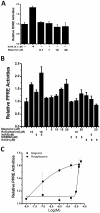Molecular determinants of magnolol targeting both RXRα and PPARγ
- PMID: 22140563
- PMCID: PMC3226690
- DOI: 10.1371/journal.pone.0028253
Molecular determinants of magnolol targeting both RXRα and PPARγ
Abstract
Nuclear receptors retinoic X receptor α (RXRα) and peroxisome proliferator activated receptor γ (PPARγ) function potently in metabolic diseases, and are both important targets for anti-diabetic drugs. Coactivation of RXRα and PPARγ is believed to synergize their effects on glucose and lipid metabolism. Here we identify the natural product magnolol as a dual agonist targeting both RXRα and PPARγ. Magnolol was previously reported to enhance adipocyte differentiation and glucose uptake, ameliorate blood glucose level and prevent development of diabetic nephropathy. Although magnolol can bind and activate both of these two nuclear receptors, the transactivation assays indicate that magnolol exhibits biased agonism on the transcription of PPAR-response element (PPRE) mediated by RXRα:PPARγ heterodimer, instead of RXR-response element (RXRE) mediated by RXRα:RXRα homodimer. To further elucidate the molecular basis for magnolol agonism, we determine both the co-crystal structures of RXRα and PPARγ ligand-binding domains (LBDs) with magnolol. Structural analyses reveal that magnolol adopts its two 5-allyl-2-hydroxyphenyl moieties occupying the acidic and hydrophobic cavities of RXRα L-shaped ligand-binding pocket, respectively. While, two magnolol molecules cooperatively accommodate into PPARγ Y-shaped ligand-binding pocket. Based on these two complex structures, the key interactions for magnolol activating RXRα and PPARγ are determined. As the first report on the dual agonist targeting RXRα and PPARγ with receptor-ligand complex structures, our results are thus expected to help inspect the potential pharmacological mechanism for magnolol functions, and supply useful hits for nuclear receptor multi-target ligand design.
Conflict of interest statement
Figures




Similar articles
-
Linked magnolol dimer as a selective PPARγ agonist - Structure-based rational design, synthesis, and bioactivity evaluation.Sci Rep. 2017 Oct 20;7(1):13002. doi: 10.1038/s41598-017-12628-5. Sci Rep. 2017. PMID: 29057944 Free PMC article.
-
Magnolol dimer-derived fragments as PPARγ-selective probes.Org Biomol Chem. 2018 Oct 3;16(38):7019-7028. doi: 10.1039/c8ob01745j. Org Biomol Chem. 2018. PMID: 30232493 Free PMC article.
-
Heterodimer formation with retinoic acid receptor RXRα modulates coactivator recruitment by peroxisome proliferator-activated receptor PPARγ.J Biol Chem. 2021 Jul;297(1):100814. doi: 10.1016/j.jbc.2021.100814. Epub 2021 May 31. J Biol Chem. 2021. PMID: 34081964 Free PMC article.
-
Insights into Dynamic Mechanism of Ligand Binding to Peroxisome Proliferator-Activated Receptor γ toward Potential Pharmacological Applications.Biol Pharm Bull. 2021;44(9):1185-1195. doi: 10.1248/bpb.b21-00263. Biol Pharm Bull. 2021. PMID: 34471046 Review.
-
Natural product agonists of peroxisome proliferator-activated receptor gamma (PPARγ): a review.Biochem Pharmacol. 2014 Nov 1;92(1):73-89. doi: 10.1016/j.bcp.2014.07.018. Epub 2014 Jul 30. Biochem Pharmacol. 2014. PMID: 25083916 Free PMC article. Review.
Cited by
-
Polyacetylenes from Oplopanax horridus and Panax ginseng: Relationship between Structure and PPARγ Activation.J Nat Prod. 2020 Apr 24;83(4):918-926. doi: 10.1021/acs.jnatprod.9b00691. Epub 2020 Mar 4. J Nat Prod. 2020. PMID: 32129622 Free PMC article.
-
Linked magnolol dimer as a selective PPARγ agonist - Structure-based rational design, synthesis, and bioactivity evaluation.Sci Rep. 2017 Oct 20;7(1):13002. doi: 10.1038/s41598-017-12628-5. Sci Rep. 2017. PMID: 29057944 Free PMC article.
-
Activation of PPARγ Protects Obese Mice from Acute Lung Injury by Inhibiting Endoplasmic Reticulum Stress and Promoting Mitochondrial Biogenesis.PPAR Res. 2022 Sep 28;2022:7888937. doi: 10.1155/2022/7888937. eCollection 2022. PPAR Res. 2022. PMID: 36213491 Free PMC article.
-
NSC-640358 acts as RXRα ligand to promote TNFα-mediated apoptosis of cancer cell.Protein Cell. 2015 Sep;6(9):654-666. doi: 10.1007/s13238-015-0178-9. Epub 2015 Jul 9. Protein Cell. 2015. PMID: 26156677 Free PMC article.
-
The Inhibitory Effect of Magnolol on the Human TWIK1 Channel Is Related to G229 and T225 Sites.Molecules. 2023 Sep 27;28(19):6815. doi: 10.3390/molecules28196815. Molecules. 2023. PMID: 37836658 Free PMC article.
References
-
- Altucci L, Leibowitz MD, Ogilvie KM, de Lera AR, Gronemeyer H. RAR and RXR modulation in cancer and metabolic disease. Nat Rev Drug Discov. 2007;6:793–810. - PubMed
-
- de Lera AR, Bourguet W, Altucci L, Gronemeyer H. Design of selective nuclear receptor modulators: RAR and RXR as a case study. Nat Rev Drug Discov. 2007;6:811–820. - PubMed
-
- Germain P, Chambon P, Eichele G, Evans RM, Lazar MA, et al. International Union of Pharmacology. LXIII. Retinoid X receptors. Pharmacol Rev. 2006;58:760–772. - PubMed
-
- Mohler ML, He Y, Wu Z, Hwang DJ, Miller DD. Recent and emerging anti-diabetes targets. Med Res Rev. 2009;29:125–195. - PubMed
-
- Baggio LL, Drucker DJ. Therapeutic approaches to preserve islet mass in type 2 diabetes. Annu Rev Med. 2006;57:265–281. - PubMed
Publication types
MeSH terms
Substances
LinkOut - more resources
Full Text Sources
Research Materials

